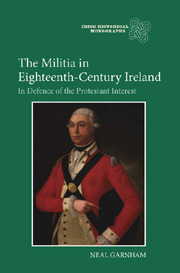Book contents
- Frontmatter
- Contents
- Preface
- Acknowledgments
- Abbreviations
- Introduction: Militia issues
- 1 To 1691: Precursors
- 2 1692–1716: Establishment
- 3 1716–59: Maintenance
- 4 1760: Action
- 5 1761–69: Reform Debated and Attempted
- 6 1769–78: Reform Achieved
- 7 1778–82: Volunteering Ascendant
- 8 1782–85: Fencible Men and the Militia Reconsidered
- 9 1785–93: Indecision and an Act
- 10 Conclusions
- Bibliography
- Index
1 - To 1691: Precursors
Published online by Cambridge University Press: 05 February 2013
- Frontmatter
- Contents
- Preface
- Acknowledgments
- Abbreviations
- Introduction: Militia issues
- 1 To 1691: Precursors
- 2 1692–1716: Establishment
- 3 1716–59: Maintenance
- 4 1760: Action
- 5 1761–69: Reform Debated and Attempted
- 6 1769–78: Reform Achieved
- 7 1778–82: Volunteering Ascendant
- 8 1782–85: Fencible Men and the Militia Reconsidered
- 9 1785–93: Indecision and an Act
- 10 Conclusions
- Bibliography
- Index
Summary
The practice of Protestant civilians in Ireland banding together to act in defence of themselves and the state probably dates back to the earliest efforts of the Crown to establish Protestant colonies in the country. Under the Tudors and Stuarts a series of ‘plantations’ were undertaken, in which English, and eventually Scottish, settlers were brought to Ireland and established in communities across the country. The intentions were to develop the country economically and socially, promote Protestantism, and secure the territory from both foreign invasion and domestic rebellion. The creation of King's and Queen's Counties from the territories of Laois and Offaly in the 1550s was the first such venture. Begun as a purely military enterprise, it developed into a much wider attempt to settle the area. In 1556 explicit instructions were issued by the Crown that those receiving land were to equip themselves with weapons and be prepared ‘without wages, for service within that our realm against all enemies, rebels and traitors’. Additionally, for every ploughland granted they were to maintain an English archer. The Munster plantation, begun almost thirty years later, saw similar seigniorial responsibilities imposed, with the result that a 12,000- acre estate would have yielded a force of 15 horsemen and 48 foot soldiers to be raised from the tenantry. The Ulster plantation, begun in 1609, required the new proprietors to provide arms for their tenants. Establishing a militia amongst the ‘stubborn and rebellious people’ of Ulster had been an early consideration.
- Type
- Chapter
- Information
- The Militia in Eighteenth-Century IrelandIn Defence of the Protestant Interest, pp. 5 - 13Publisher: Boydell & BrewerPrint publication year: 2012



